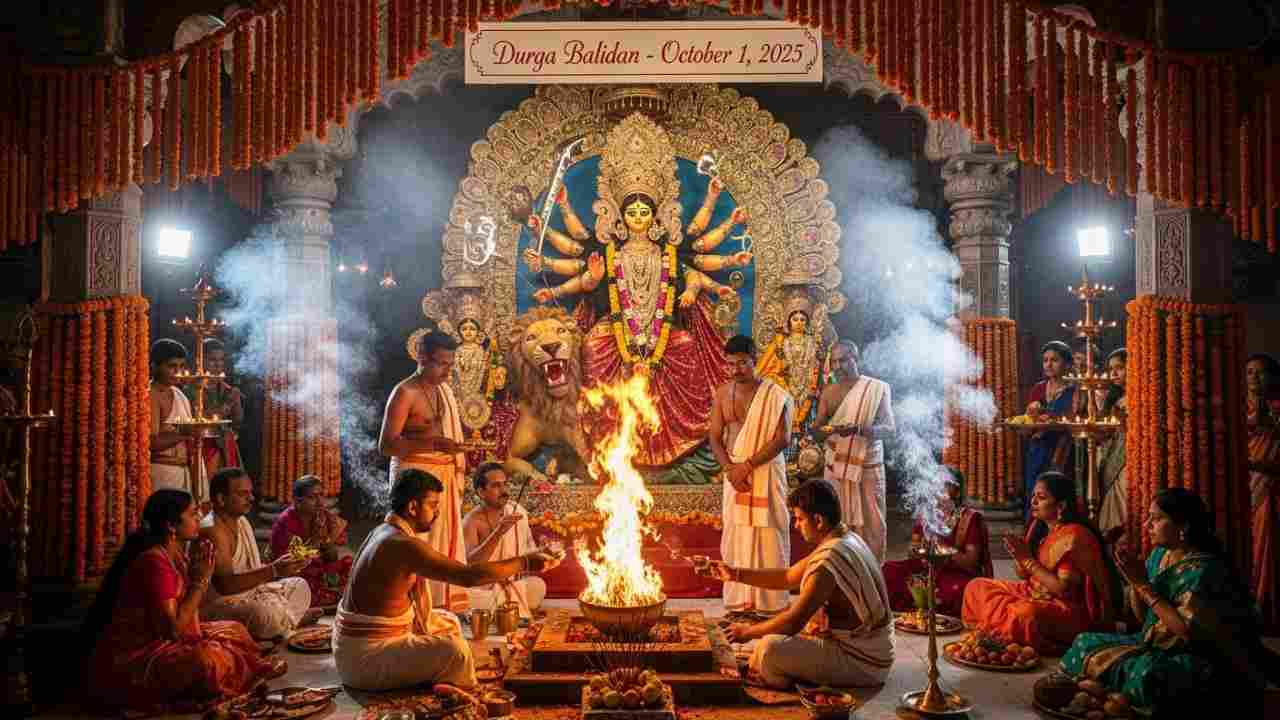
Have you ever wondered why Durga Balidan holds such a sacred place in the grand celebration of Navratri and Durga Puja? While the nine nights of Navratri are filled with devotion, dance, and festivity, the ritual of Durga Balidan is performed on Maha Navami. It is believed to be one of the most powerful offerings to Goddess Durga.
In this blog, we’ll uncover when is Durga Balidan in 2025, its historical roots, spiritual meaning, the Durga Balidan mantra, and how devotees across India observe it.
When is Durga Balidan in 2025?
In 2025, Durga Balidan will be observed on Wednesday, October 1, 2025, coinciding with Maha Navami, the ninth and final day of Navratri and Durga Puja. This ritual marks the conclusion of the grand worship of Goddess Durga and is often referred to as Maha Navami Homa.
On this day, devotees offer symbolic sacrifices traditionally animals in ancient times. But today often replaced with vegetarian offerings like pumpkins, sugarcane, cucumbers, or ash gourd. It represents the surrender of ego, pride, and negativity to the Divine Mother.
The Meaning of Durga Balidan
The word Balidan means “sacrifice” or “offering.” In the context of Durga Balidan:
- It symbolizes surrendering worldly desires at the feet of Goddess Durga.
- It represents the destruction of negative tendencies like greed, anger, and ego.
- It is believed that performing Balidan on Maha Navami pleases Goddess Durga and grants victory, protection, and prosperity.
In Shakta tradition, this ritual is one of the most intense forms of devotion, showing absolute faith in the Goddess’s power to remove darkness and restore balance.
Rituals of Durga Balidan in 2025

On October 1, 2025, devotees across India will perform Durga Balidan with different traditions. Key rituals include:
1. Maha Navami Puja
- The ninth day begins with Shodashopachara Puja (16 steps of worship).
- Devotees decorate the idol of Goddess Durga with flowers, red cloth, sindoor, and jewelry.
- Offerings of fruits, sweets, and coconuts are made.
2. Symbolic Sacrifice (Balidan)
- Traditionally, kings and priests performed animal sacrifices to signify courage and surrender.
- Today, this is mostly replaced with symbolic sacrifices like cutting a pumpkin, sugarcane, or cucumber, marking the destruction of inner negativity.
3. Homa / Yajna (Sacred Fire Ritual)
- A fire ritual called Maha Navami Homa is performed with the chanting of mantras.
- Ghee, grains, and herbs are offered into the fire, invoking divine blessings.
4. Durga Balidan Mantra Chanting
Devotees chant specific Durga Balidan mantras to seek strength and divine protection. A popular one is:
“Sarva-badha prashamanam trailokyasya akhileshwari,
Evameva tvaya karyaṁ asmat vairi vināshanam.”
(Meaning: O Mother of the Universe, destroy all troubles and obstacles and remove the enemies within and outside us.)
5. Kanya Puja (Worship of Young Girls)
- Nine little girls, representing the nine forms of Goddess Durga, are invited and worshipped.
- They are offered food, clothes, and gifts as a symbolic gesture of honoring the feminine divine.
Significance of Durga Balidan
Durga Balidan is not just a ritual. It is a spiritual philosophy.
- It represents victory of good over evil.
- It teaches devotees to sacrifice ego and negative thoughts.
- It is believed to bring protection, peace, and prosperity to households.
- Spiritually, it aligns devotees with the universal power of Shakti (divine feminine energy).
In Bengal, Odisha, Assam, and other eastern states, Durga Balidan is part of Durga Puja festivities, while in North India, it coincides with Ram Navami celebrations in Navratri.
Regional Practices of Durga Balidan

- West Bengal & Assam: Animal sacrifice (mainly goats) is still practiced in certain traditional temples, while many modern devotees opt for pumpkin or sugarcane sacrifices.
- Odisha: Known for symbolic Balidan where a white pumpkin or gourd is cut during the ritual.
- North India: Emphasis is given on Kanya Puja and Maha Navami Havan.
- Nepal: Durga Balidan (known as Maha Navami Bali) is part of Dashain, the biggest Hindu festival.
Durga Balidan Mantras
Chanting mantras during Durga Balidan is believed to amplify spiritual power. Some important ones are:
- Durga Gayatri Mantra
Om Katyayanaya Vidmahe, Kanyakumarim Dhimahi, Tanno Durgih Prachodayat. - Maha Navami Homa Mantra
Ya Devi Sarvabhuteshu Shakti Rupena Samsthita,
Namastasyai, Namastasyai, Namastasyai Namo Namah. - Balidan Mantra
Sarva-badha prashamanam trailokyasya akhileshwari…
Lessons from Durga Balidan
- Sacrifice is not loss but transformation of the self.
- True strength comes from letting go of ego.
- Worship of the Divine Mother is about honoring feminine power and universal energy.
- Durga Balidan is a reminder that life’s battles can be won with faith, surrender, and purity of heart.
Durga Balidan in Modern Times

In today’s world, where rituals are evolving, Durga Balidan is often performed with a focus on symbolic sacrifice. Cutting a pumpkin or sugarcane has replaced animal offerings in most households and temples, reflecting a shift towards non-violence and inner transformation.
Durga Balidan, celebrated on Maha Navami (October 1, 2025), is a sacred reminder of surrender, sacrifice, and spiritual renewal. Whether observed through symbolic offerings, fire rituals, or mantra chanting, this ritual continues to inspire millions with its timeless message of true victory lies in conquering the negativity within.
By performing Durga Balidan, devotees invite Goddess Durga’s blessings of strength, protection, and prosperity into their lives.
Want to explore more about Navratri rituals? Check out our guide on Navratri 2025 Dates and Significance.
FAQs
Q1. When is Durga Balidan in 2025?
Durga Balidan in 2025 will be observed on Wednesday, October 1, on the day of Maha Navami.
Q2. What is Durga Balidan?
Durga Balidan is a ritual of symbolic sacrifice performed on Maha Navami to honor Goddess Durga by surrendering ego, negativity, and desires.
Q3. Is animal sacrifice still practiced in Durga Balidan?
In some traditional temples, yes. However, in most places, it is replaced with symbolic offerings like pumpkin, sugarcane, or cucumber.
Q4. What is the significance of Durga Balidan?
It signifies the destruction of negativity and the victory of good over evil. It also marks the conclusion of Durga Puja celebrations.
Q5. Which mantra is chanted during Durga Balidan?
The Durga Balidan Mantra and Durga Gayatri Mantra are commonly recited, along with verses from the Devi Mahatmya.
Q6. Is Durga Balidan the same as Maha Navami Homa?
Yes, Durga Balidan is also known as Maha Navami Homa, performed with fire rituals and offerings to the Goddess.
Q7. How is Durga Balidan celebrated in Bengal and Odisha?
In Bengal, traditional temples may perform animal sacrifice, while in Odisha symbolic offerings like pumpkin are more common.
Q8. Why is pumpkin used in symbolic Balidan?
The pumpkin represents the human ego. Cutting it symbolizes surrendering the ego to Goddess Durga.
Q9. Can Durga Balidan be performed at home?
Yes. Many devotees perform a simplified version with symbolic sacrifice, chanting mantras, lighting a lamp, and offering prayers at home.
Q10. What blessings are believed to come from performing Durga Balidan?
It is believed to remove obstacles, destroy negativity, bring peace, and grant strength, courage, and prosperity.

